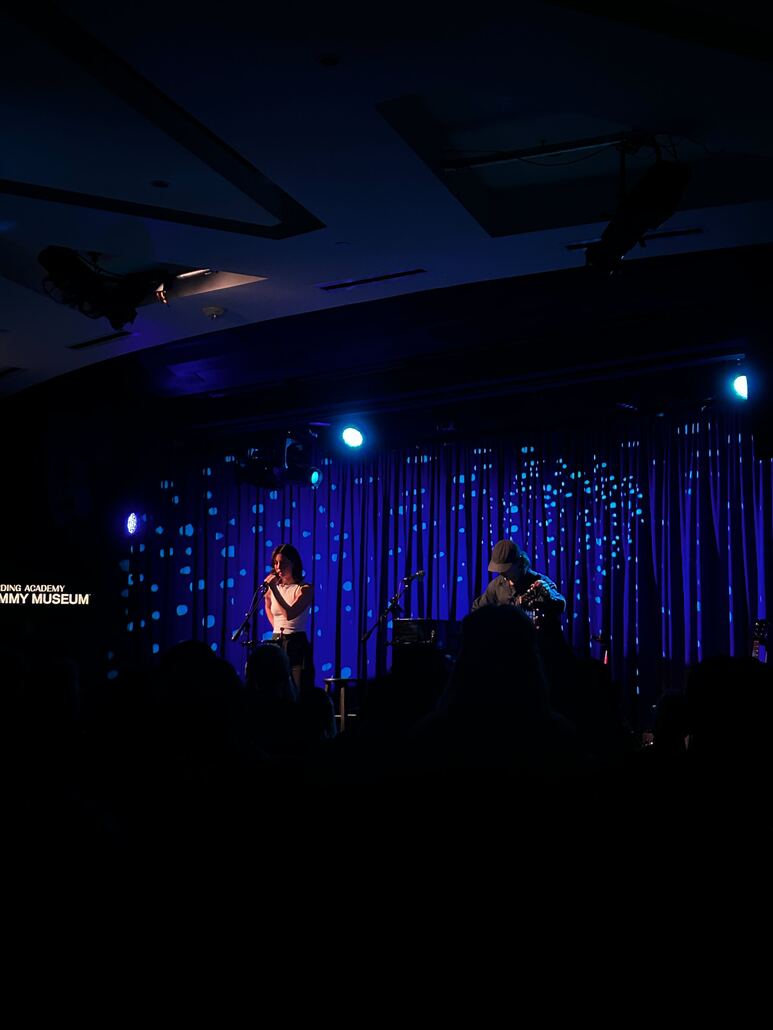‘Good Riddance’ writers stun audiences
Gracie Abrams and Aaron Dessner dazzled audiences at the GRAMMY Museum.
Gracie Abrams and Aaron Dessner dazzled audiences at the GRAMMY Museum.

Gracie Abrams and Aaron Dessner spoke to the creation of their album “Good Riddance” and opened up about the instrumental events that helped shape their careers to an excited 200-person audience at the Clive Davis Theater Wednesday night. Chris Willman, a senior music writer and chief music critic at Variety, moderated the GRAMMY Museum Spotlight event.
The event hosted a conversation between Abrams, Dessner and Willman to discuss the creation of their album. After the interview, Abrams and Dessner put on a short performance of their discography.
Once the music started, the duo lost themselves in their lyrics. The show’s acoustic nature added to the songs’ fire, highlighting some of the more angelic notes and guitar chords.
While many of the songs off of “Good Riddance” are sad, Abrams sung them with a passion unique to a live performance. Her fans filled the audience, ribbon-tied hair and flowery skirts adorning the theater. It was a unique experience to spend such close-knit and casual time with Abrams and Dessner, who don’t often perform on a small stage.
“Good Riddance” was 23-year-old Abrams’ debut album, though she had previously released two EPs — “Minor” and “This Is What It Feels Like.” Her raw and emotional music, detailing universal experiences like first love, heartbreak and continuous missteps, resonates with young fans.
Abrams recently performed as an opening act at Taylor Swift’s Eras Tour, an accomplishment that greatly expanded her notability. She discussed how this life-changing opportunity has impacted her career.
“Oh, that was the best experience of my life,” Abrams said Wednesday. “I’m very used to spaces that feel quite like this where there’s an intimacy. We can see each other and make eye contact and have real conversations. And then, all of a sudden, you’re in a stadium and you feel like a grain of sand.”
Compared to Abrams’ more recent dive into the music industry, Dessner has had a long career as a musician. The GRAMMY award-winning producer and songwriter is a founding member of rock band The National and creator of four albums that hit the Top 5 of the Billboard 200.

Branching out in his musical expertise, Dessner worked as Swift’s chief songwriting partner for her last three albums. He discussed how working with Abrams clicked easily.
“You’re always nervous when someone comes for the first time, and you jump off the cliff together of collaborating,” Dessner said. “It’s a vulnerable moment, because … you don’t even know how you’re going to work together. With [Abrams], it was just instantaneous.”
Though the duo only recently became musical partners, Dessner and Abrams effortlessly churned out music at Long Pond Recording Studio Fall of 2021.
“I’d seen [Abrams] do an interview where she talked about laying on the floor in the studio, sort of pouring out her life and songs,” Willman said.
In between their morning coffee, tireless pacing and the occasional lay on the floor, they wrote three or four songs in a day at the studio.
“I will often open my journal and go back and reference specific thoughts, but with the music that [Dessner] comes up with in 0.2 seconds, it triggers a feeling or a memory like an actual trigger in real life,” Abrams said.
Abrams and Dessner meet eye-to-eye the most on the purpose and impact of their creations. In an algorithm-driven space, the fragility and emotion behind their music builds a rapport with their audience. Displays of such vulnerability are transformative to the messages they hope to convey, they said.
“It’d be nice to make a perfect pop song,” Desser said. “But it’s not my goal in life. What I would like to do is make music that I can really feel and that can take many forms.”
Releasing such emotionally compelling music isn’t only important in how Abrams and Dessner connect with each other — it’s also a means of cathartic personal reflection.
“Looking at the music that I’ve put out, it’s almost like the most immediate version of me observing all the ways that I have changed as a person, and I pray I continue to change constantly,” Abrams said.
Like many artists, Abrams and Dessner interact with the world through a poetic lens. Instead of viewing collaboration as a subtraction of individual ideas, they discussed it as the most transformative aspect of music. Even with the pressure of social media to create algorithm-driven art, the two manage to conserve a safe space for their art.
“We all have access to the internet and everyone’s opinions are all over the place all the time, but I do think it’s funny because with writing, it’s like the writing of it all is where my heart is in music,” Abrams said.
After an open conversation about their careers, Abrams and Dessner collaborated onstage for a short performance. The intimate space was unlike the recent stadium shows Abrams performed, allowing for a surplus of fan interaction and transparency.
Before they left the stage, Abrams and Dessner hinted at a future collaboration. While “Good Riddance” continues to find itself on fans’ playlists, it is only the stepping-off point for the art that is to come.
We are the only independent newspaper here at USC, run at every level by students. That means we aren’t tied down by any other interests but those of readers like you: the students, faculty, staff and South Central residents that together make up the USC community.
Independence is a double-edged sword: We have a unique lens into the University’s actions and policies, and can hold powerful figures accountable when others cannot. But that also means our budget is severely limited. We’re already spread thin as we compensate the writers, photographers, artists, designers and editors whose incredible work you see in our daily paper; as we work to revamp and expand our digital presence, we now have additional staff making podcasts, videos, webpages, our first ever magazine and social media content, who are at risk of being unable to receive the compensation they deserve.
We are therefore indebted to readers like you, who, by supporting us, help keep our paper daily (we are the only remaining college paper on the West Coast that prints every single weekday), independent, free and widely accessible.
Please consider supporting us. Even $1 goes a long way in supporting our work; if you are able, you can also support us with monthly, or even annual, donations. Thank you.
This site uses cookies. By continuing to browse the site, you are agreeing to our use of cookies.
Accept settingsDo Not AcceptWe may request cookies to be set on your device. We use cookies to let us know when you visit our websites, how you interact with us, to enrich your user experience, and to customize your relationship with our website.
Click on the different category headings to find out more. You can also change some of your preferences. Note that blocking some types of cookies may impact your experience on our websites and the services we are able to offer.
These cookies are strictly necessary to provide you with services available through our website and to use some of its features.
Because these cookies are strictly necessary to deliver the website, refusing them will have impact how our site functions. You always can block or delete cookies by changing your browser settings and force blocking all cookies on this website. But this will always prompt you to accept/refuse cookies when revisiting our site.
We fully respect if you want to refuse cookies but to avoid asking you again and again kindly allow us to store a cookie for that. You are free to opt out any time or opt in for other cookies to get a better experience. If you refuse cookies we will remove all set cookies in our domain.
We provide you with a list of stored cookies on your computer in our domain so you can check what we stored. Due to security reasons we are not able to show or modify cookies from other domains. You can check these in your browser security settings.
These cookies collect information that is used either in aggregate form to help us understand how our website is being used or how effective our marketing campaigns are, or to help us customize our website and application for you in order to enhance your experience.
If you do not want that we track your visit to our site you can disable tracking in your browser here:
We also use different external services like Google Webfonts, Google Maps, and external Video providers. Since these providers may collect personal data like your IP address we allow you to block them here. Please be aware that this might heavily reduce the functionality and appearance of our site. Changes will take effect once you reload the page.
Google Webfont Settings:
Google Map Settings:
Google reCaptcha Settings:
Vimeo and Youtube video embeds:
The following cookies are also needed - You can choose if you want to allow them:
